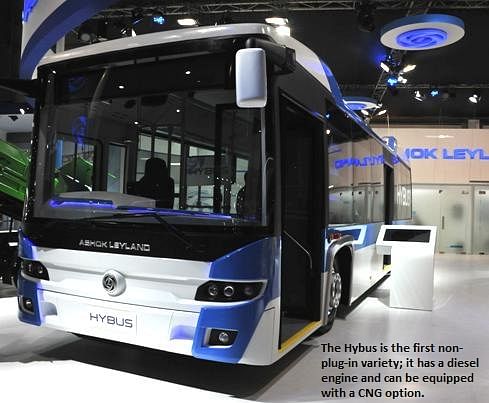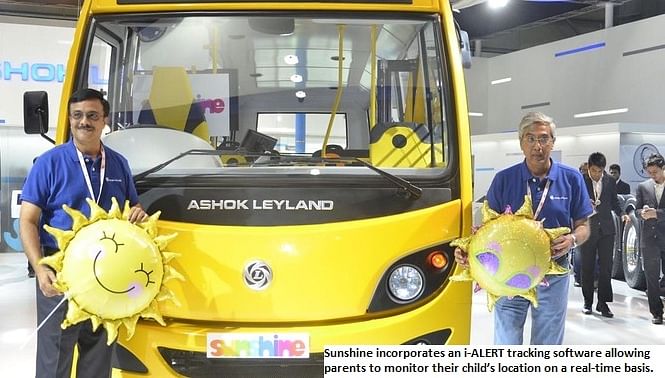‘We involved children in the conceptual design of the Sunshine school bus and took their feedback to ensure they are happy when they travel in it.’
Anuj Kathuria, President (Operations and Project Planning), Ashok Leyland speaks on new product development, OEM-supplier connect, the recently revealed Hybus and meeting BS VI norms.
Anuj Kathuria, President (Operations and Project Planning), Ashok Leyland, who is soon to take over as president – Trucks, Ashok Leyland, speaks to Shobha Mathur on new product development, OEM-supplier connect, the recently revealed Hybus and meeting BS VI norms. Excerpts from the interview.
You are taking over charge of Ashok Leyland’s trucking business from April 1. What will be your priorities?
Our customers are looking for vehicles that offer reliability. Some of them are suppliers, logistics providers or e-commerce people who have to move vehicles from one point to another and for whom time is very important. So vehicle reliability and fewer instances of vehicle breakdown are key parameters for them. That will come from component reliability, component design and a lot of testing and validation.
We are working on a project called Reach 90 that means at least 90 percent of the vehicles should not have a failure during the warranty period. It involves identifying all the weak links in the vehicle, partnering with our suppliers and also improving our in-house capabilities. We work from the design stage on how the component or the aggregate gets integrated into the product.
How closely does Ashok Leyland work with its suppliers?
When we start development work on a platform or a product, we work with Tier 1s who in turn partner Tier2. Generally, the Tier 1s are the ones who bring in the technology so it is more important for us to partner with them.
In the truck portfolio which, in your opinion, are the areas you need to further strengthen?
We have a weak link in the 4x2 tractor area. The 49T segment has always had good products. Now for the 40 tonner segment, wherein we recently launched the Captain iT tractor in the Captain series, we have come up with a unique proposition to take care of customer requirements. Most of them take one- side load and return empty; with this truck, when returning empty the driver switches to economy mode, which ensures fuel consumption is less. It is like having two engines in the same vehicle, one which works in load conditions and the other when empty.
Which are the new products that Ashok Leyland is working on?
Some aspects have to be considered – how the vehicles are being operated in the field and how fleet owners can keep a watch over what’s happening. We are now working on integrating the vehicles to let the fleet owner watch over the vehicle. GPS also gives alerts on vitals – iAlerts – related to fuel consumption; for instance is an oil change coming up, is the vehicle behaving abnormally?
Another platform where vehicles are being monitored for vitals in truckers language is called ‘Tel’ or oil and hawa paani. The initial pilot is underway with fleet operators and it will be launched this year in the truck segment.
Which are the new technologies that we could see in the future?
Technologies will be more safety related and in the area of driver comfort. For instance, a tractor-trailer coming with features like electronic braking system ahead of ABS. Airbags can be provided but this tractor trailer segment does not need them. We meet all the frontal crash safety regulations – at a 90kph collision, the driver will not get injured.
Can you detail the company’s plans in the electric and hybrid bus segment?
We have a hybrid bus called Hybus which is the first non-plug-in variety – you don’t have to plug in to charge its battery. It has a diesel engine and can also be equipped with a CNG option. A unique aspect is that it is a conventional hybrid with ultra-capacitors that can take in energy that is decapitated during braking. We have a couple of partners for sourcing ultra-capacitors. The technology is available at our bus manufacturing plant of Optare in UK and will be a relatively new technology for India, far ahead of lithium ion. Its advantage is that it can withstand frequent discharge and charge and will ensure in cost economies in case of scale output.

Recommended: CV makers reveal green mobility initiatives at Auto Expo 2016
Can you elaborate on the product planning that went into the development of the four new products Ashok Leyland unveiled at the Auto Expo? What are the steps that you are taking to modernise the CV segment?
All these products – the Sunshine school bus, the Hybus plug-in hybrid, the 4940 Euro 6 truck, and the Guru in the intermediate truck segment – cater to different customer segment requirements, so the process followed for development caters to varied customer needs.
The process followed for development in the overall framework was similar but there would be a specific customised approach for each product. A common factor which weighed across for all was the end user and also all the stakeholders because in the Indian context there are people who buy the vehicles, operate the vehicles.
As an example, let’s take the Sunshine schoolbus. Its stakeholders are the children who travel in it, the school authorities who are the decision makers, the parents. Even the bus driver has a lot of responsibility and he is generally the one who gets blamed if something goes wrong. Naturally, his requirements and the fatigue that he experiences is kept in mind as there are narrow lanes to drop off children; so there are numerous challenges for them also.

What we did is that we involved children in the conceptual design of this bus since they are the ones who travel in it and we need to understand why and how they feel happy in it.
We took a lot of feedback and found that they were not very comfortable (in other buses); the interiors are very drab. Children take to vibrant colours, so the interiors of the new school is something which appeals to them. The bus is also much safer. It meets the rollover compliance. It has not been mandated in the Bus Body Code so we are ahead of the mandated safety norms.
Since children should not pick up any infections from the bus, all the seats and furnishings are anti-bacterial. Another important area is the concern of parents. The bus offers alerts – an RFID tag on the child’s wrist has it that when he/she gets inside the bus, the parent will get a message that the child has boarded the bus. Five minutes before the bus is nearing the student’s destination, an alert goes to the parent. The focus on developing this product is to meet the end to end challenges
We give what the customer wants and in a way that is acceptable to the entire range of customers and also meets their requirements. We are not bringing technologies from developed countries as that will be very expensive as India is finally a very price-sensitive market.
Our technology has been developed in-house and we have partnered with our suppliers for it. Many are existing suppliers and many have been brought specially for this development. We have 50 strategic partners who partner with us on technology. Localisation is almost 100 percent on it. Going forward, we will indigenise technology for other products for which we are yet to start commercial production.
How many people have worked on the development of the Sunshine school bus?
There is a core team of 100 people encompassing engineering, sourcing and manufacturing. We interacted with several schools and collected a lot of relevant feedback.
How is Ashok Leyland moving towards the Euro 6 emission roadmap?
We have to control both the NoX and the particulate matter and in India we are still at BS-III and are getting into BS-IV in the coming year. In other countries, the journey from Euro 4 to Euro 6 took place over a 10-year period. In India, we are trying to do it within three years. We understand that we are lagging but it requires a lot of work. Every manufacturer in Europe has its own way of getting to BS-VI and we have done it in a certain way but going forward there can be different other ways of doing it.
How important were principles of cost optimisation, utilisation of space and fuel efficiency in development of products?
Basically a lot of information is provided by customers. Then we rank them in order of priority and have to be best in class. So there is a lot of benchmark data in on-going development. We also have to keep in mind the positioning of the product in a particular segment.
Cost has to be optimised and the time to market has to be very fast while meeting the customer requirements. Customers would be looking for more customised products but customisation has a trade-off with complexities in operation. If you have to strike the right balance, the way forward would be having a modular approach.
How many more models can be developed on these platforms?
Today what the customer wants on a platform are different types of wheelbases, different lengths of the vehicle, as what he loads will be different. Someone wanting volumetric space will look for a larger wheelbase with the same engine horsepower. Others may want a more compact floor, so a smaller vehicle works for them. Then the seating configuration in a staff bus or schoolbus is different, so all these variants evolve from the base platform. All this is best done when the product is being designed otherwise it makes it that much more complicated.
What is the current crop of engines being developed in the company’s R&D centre?
We have the Neptune and the H Series of engines. If you look at the Guru, this is an intermediate CV in the 10T and 13T segment and comes with a three-cylinder engine that is a first for a commercial vehicle. This is with common rail and is completely indigenously developed. The Neptune range is four-cylinder and six- cylinder and is BS-VI compliant. This one also can be worked upon to meet advanced emission requirements.
Would you be developing a new series of engines going forward?
That is work in progress and can include both options of new ones and modification of existing engines based on timing and cost. The strategy would be to meet customer requirements. In the next 3-4 years we have to be prepared if it is mandated.
In terms of operations, our focus in operations is to be more nimble footed as the demand in the marketplace has become very volatile. Any demand which comes is here and now and the option for
the customer has increased over time. All the players who came in have set up capacity so the overall capacity in the Indian space is twice the peak demand with everyone trying to woo the customer. This year, our capacity utilisation will be pretty good; maybe over 70-75 percent.
RELATED ARTICLES
TVS Celebrates 20 Years of Apache, Eyes Premium and Global Push
Marking two decades of its flagship performance brand, TVS Motor unveiled special anniversary editions on Saturday while...
Q&A: Mahindra's Nalinikanth Gollagunta on Upcoming Festive Season, 'Bold' Design Choices
Automotive Division CEO Nalinikanth Gollagunta says mid-teens growth is achievable with Roxx ramp-up, BEVs, and a resil...
Tata Hitachi’s Next Act: Mining, Exports, and Electrification to Power Growth
Under Sandeep Singh, the construction equipment maker has moved from stabilisation to a sharper strategic focus, positio...






 By Shobha Mathur
By Shobha Mathur
 14 Mar 2016
14 Mar 2016
 7655 Views
7655 Views





 Darshan Nakhwa
Darshan Nakhwa



 Yukta Mudgal
Yukta Mudgal

